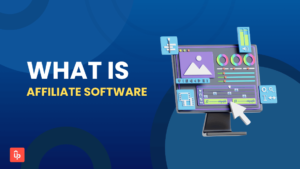Affiliate marketing has emerged as a highly popular method for earning money online. As a publisher, your role involves promoting products from various brands and earning commissions on successful sales. Creating an effective affiliate marketing website is essential to grasp these lucrative opportunities.
The good news is that building an affiliate marketing website is accessible to everyone. Selecting a specific niche and setting up a site lets you quickly join affiliate programs and start promoting products.
This guide will provide a step-by-step walkthrough on creating your affiliate marketing website using the free platform.
Let’s begin!
What is Affiliate Marketing?
Affiliate marketing has a straightforward formula of Sign up – Share – Earn. That is basically affiliate marketing for beginners, right? Although it sounds clear and simple, the model can still confuse some people from the start.
Guess what? The top affiliate marketers are raking in impressive six or even seven-figure incomes!
So, why do so many people love affiliate marketing? There are several reasons for its popularity:
- Low initial costs and great returns on investment.
- You don’t have to create your own product or service.
- No stress about shipping products.
- Say goodbye to handling customer support.
- No need for a team, office, or other overhead expenses.
In a nutshell, affiliate marketing offers fantastic benefits with minimal hassle!
How Does Affiliate Marketing Work?
This is how affiliate marketing works to help you earn money by promoting product/service links within top affiliate networks worldwide. Once you register for an affiliate program, you will receive specific links to share with your audiences. Then, the commission is yours when someone purchases via your links.
Many merchants operate affiliate programs, allowing affiliate marketers to join and promote their products and services.
TréSkin is a USA top-favored organic beauty & health brand with an affiliate program.
Once you sign up and get approved for the TreSkin affiliate program, you’ll access your unique affiliate links through your account dashboard.
With your affiliate link, you can start promoting it on different platforms. Whenever a customer clicks on your link and makes a purchase, you’ll earn a commission for your efforts.
What is an Affiliate Marketing Website?
Affiliate websites allow publishers to advertise digital or physical products from manufacturers or retailers. As a publisher, you don’t own these products; your role is to promote them using special affiliate links and earn a commission for each sale.
To create a successful affiliate website, it’s best to focus on a specific niche people are passionate about and willing to spend money on. You can also target holidays like Halloween, Easter, Thanksgiving, and Christmas, where you can promote costumes and decorative items on your website.
Why Should You Create an Affiliate Marketing Website?
There are two ways to do affiliate marketing: one is not so good, and the other is the best.
The not-so-good way involves spamming your affiliate links on social media and other places, which isn’t very effective.
The best way is to create a website for affiliate marketing and share helpful content with your audience. This way, you can be seen as an authority in your niche and gain genuine customers.
Building a website also allows you to attract targeted traffic from search engines, making your efforts more successful. Plus, many affiliate programs require you to have a website.
Specifically, advertisers and publishers benefit significantly from affiliate marketing, earning hundreds to thousands of dollars monthly.
Here are some more reasons to consider create a website:
- Easy to start: Starting an affiliate website is simple and doesn’t require a lot of money. You can create a website regardless of your current financial situation, and even if you don’t have many resources, you can still work as an affiliate.
- Flexibility: You don’t need to monitor your affiliate website constantly. You can be an affiliate marketer while holding a full-time job or traveling.
- Unlimited earning potential: As your website grows and attracts more visitors, your earnings can increase significantly.
- Low risk: Unlike other financial ventures, affiliate marketing doesn’t involve high risks or strict commitments.
So, the best approach is to create an affiliate marketing website and do it correctly!
How to Create A Website for Affiliate Marketing? (8 Easy Steps)
This section is for those interested in learning how to create an affiliate marketing website. We have divided the process into 8 simple steps that are easy to follow. By following these steps, you’ll be well on your way to launching your affiliate marketing business in no time.
Choose An Affiliate Niche
Do research to find a popular niche
As an affiliate marketer, you earn commissions by promoting products or services on your website. To achieve success, selecting a niche for your blog is crucial.
While going after the highest-paying blog niche may be tempting, we advise considering your interests. Since you’ll need to create a steady flow of content, choosing a topic you’re passionate about is best. Writing about something you genuinely care about will keep you motivated and engaged in your affiliate marketing journey.
Some popular niches with corresponding affiliate programs include
| Niche | Affiliate Program |
| Travel | TripAdvisor, Skyscanner, Booking.com |
| Consumer goods | Etsy, Amazon, Target |
| Health & Fitness | ClickBank, ShareASale |
| Tech & Gadgets | Shopify, WordPress, GoDaddy |
| Fashion & Apparel | Adidas, Lululemon, Amazon Associates |
For instance, if you have a passion for pets, you could focus on promoting pet-related products and services:
After choosing the pet niche, you’ll want to assess its popularity.
Now use Google Trends to search for relevant keywords and ensure the interest over time remains relatively steady:
Another valuable tool to refine your pet niche is Google Keyword Planner. It provides insights into the number of monthly searches for pet-related keywords. Additionally, other keyword research tools can estimate the difficulty of ranking content in Google for those specific search queries:
In general, the most promising pet niches boast consistent demand and low competition. Crafting content around these topics can help you drive organic traffic to your website, potentially resulting in increased sales.
Analyze Competitors
Once you’ve found your potential niche, it’s crucial to conduct competitor analysis to assess your standing in the market.
By analyzing your competitors, you can:
- Identify successful strategies and avoid ineffective ones within your niche.
- Capitalize on your competitors’ weaknesses to gain an advantage.
- Replicate and implement successful tactics used by your competitors.
- Determine which SEO tasks are essential to prioritize for better visibility.
- Understand the difficulty level in outperforming competitors on search engine results pages (SERPs).
Competitor analysis provides a solid plan and inspiration to kickstart your affiliate marketing journey successfully. It helps you position yourself strategically and make informed decisions to stand out in the competitive landscape.
Join An Affiliate Program
Once you’ve chosen your niche, finding suitable affiliate programs is essential.
Don’t worry; there’s an easy way to do it!
Start by becoming an affiliate for products you already use. And also, look for whether that offer provides:
- Make sure the brand has a good reputation.
- Select products that match your niche.
- Look for affiliate programs with competitive commission rates.
- Check the cookie duration (how long you get credit for a sale).
- Read the terms and conditions, especially regarding successful transactions.
By selecting familiar products and the right program, you can create resourceful content that genuinely helps your audience and boosts your credibility as a publisher.
Now that’s the criteria you need to keep in mind. Begin finding programs, but how?
Search online and consider factors like commission rates and payment schedules. Also, check out affiliate networks like UpPromote Marketplace and ShareASale, where you can find programs in various categories.
When you search for a category, it will bring up several offers with their crucial information, like commission rate, cookie, and payment types. Often, you can simply click Apply button.
Using Google is another of the easiest ways to find good affiliate programs.
Many online businesses have affiliate programs available. You can easily find them by using search queries like “site:domain.com + affiliate” or “(product name) + affiliate program” on search engines.
Another way is to check the footer of company websites by visiting the websites of companies or brands you are interested in promoting. Look for their “Affiliate” or “Partner” pages for information about their affiliate programs.
Choose a Website Hosting & Domain Builder
To build an affiliate marketing website, you need a content management system (CMS), hosting provider, domain name, and plugin installation. Follow these steps to get started:
Determine A Website Type
After choosing an affiliate niche and great programs to join, you can pick a specific website type to cater to the needs of your audience.
Here are five options, along with the best examples of each type, to inspire you:
Blog
A blog is a great way to create an affiliate marketing website. Blog owners can write about a specific topic and include relevant affiliate links within their content, providing helpful recommendations to readers without sounding like affiliate marketing scams.
One great example of a successful affiliate marketing blog is “Nomadic Matt.” This website focuses on travel and provides practical tips and advice to its audience on budget travel, saving money, and finding great deals on flights and accommodations.
Nomadic Matt earns commissions from various affiliate programs related to travel, such as booking platforms and travel gear companies. By offering valuable content and relevant affiliate links, the website has become a trusted resource in the travel niche, leading to its success in affiliate marketing.
Retail Listings websites function like eCommerce stores but showcase products from other retailers. Instead of selling their own products, they redirect customers to the respective retailer’s sites using affiliate links.
An example of this affiliate marketing website type is “This Is Why I’m Broke” (TIWIB). This website curates and showcases unique and exciting products from various online retailers.
TIWIB provides witty and entertaining descriptions of the products, which adds to its appeal and keeps visitors engaged. Each product listing includes affiliate links that direct users to the respective retailer’s website for purchase.
By featuring fun and unusual products and incorporating affiliate links seamlessly, “This Is Why I’m Broke” has gained popularity as a go-to site for quirky and exciting gift ideas, earning commissions through its affiliate marketing strategy.
Product review sites focus on describing products the website owner has personally tested or used. They may also allow contributors to write reviews based on their product experiences.
Wirecutter provides in-depth and expert product reviews across various categories, such as tech gadgets, home appliances, and outdoor gear.
Wirecutter’s team extensively researches and tests products before publishing their reviews. The website includes affiliate links to the products they recommend, which allows visitors to make purchases through the provided links.
With its reputation for thorough and unbiased reviews, “Wirecutter” has gained a loyal audience and succeeded as a go-to source for reliable product recommendations, generating revenue through its affiliate marketing strategy.
Coupon Deals Website
A daily deals website collects deals from various businesses and manufacturers in one convenient location. Visitors can find and use coupons on the website to save money.
RetailMeNot gathers various deals, coupons, and promotional codes from different retailers, helping visitors save money on purchases easily.
Protip: Before finalizing the type of website you want for affiliate marketing, it’s a good idea to search for top affiliate marketing websites in your niche. You can use them as inspiration or explore different methods that might stand out. SimilarWeb is a helpful tool for discovering websites with similar niches and gaining valuable insights.
Choose a Domain Name
You’ll also need to get a domain name, the address people type in their browser to visit your website.
Many web hosting providers offer domain name registration and hosting, so you can get both services together in one package without purchasing them separately.
Some example website names for different types of affiliate marketing websites:
Blog:
“HealthyLivingTips.com” (health and wellness blog)
“TechGizmoReview.com” (technology product review blog)
“TravelExplorerGuide.com” (a travel and adventure blog)
Commercial Listing:
“BestDealsCentral.com” (a commercial listings website with deals and discounts)
“FashionFindsHub.com” (a fashion and style listings platform)
“HomeDecorDiscoveries.com” ( a home decor and interior design listings site)
Price Comparison Website:
“CompareTechGadgets.com” (a tech gadgets price comparison site)
“SaveOnTravelDeals.com” (travel deals and discounts comparison platform)
“BestDealFinderPro.com” (a general price comparison website)
Protip: Check on SERPs whether that name has been taken or not. Also, free tools like NameCheap, BlueHost, GoDaddy, and Shopify domain name generators can be helpful.
Select a Web Host
When choosing a web hosting service, you have two options: Content Management Systems (CMS) and Website Builders. Both options offer different functionalities and customization tools and suit various skill sets and budgets.
| CMS (Content Management Systems) | Website Builders | |
| Functions | Open source software with third-party template plugins and management add-ons, providing access to various design features and layouts | A centralized platform with its own tools accessible through a subscription system, providing all website functions in one place |
| Pros | – Full design freedom, allowing you to create your own layout or choose from thousands of unique templates
– Flexible to change hosts without limitations |
– Easy to use and quick to set up
– Ensure all security and website maintenance with readily available support |
| Cons | – Take longer to learn and may require some skill in back-end designing
– Maintenance can be more involved and less intuitive |
– Limited customization and possible compatibility issues
– Your domain might belong to the platform and not you directly |
| Cost | Free installation with optional plugins and add-ons, totaling between $10-40/monthly. | Fixed subscription prices managed by the hosting platform, ranging from $15-40/monthly. |
| Examples | WordPress, Drupal, Joomla | Wix, Squarespace, Shopify |
For those with limited web design experience looking to create affiliate content, website builders like Shopify, Wix, and Squarespace are excellent risk-free options, providing all the necessary tools you’ll need.
Choose a Platform
Choosing the right platform is crucial for your affiliate marketing website as it affects its appearance, functionality, user experience, and maintenance.
Consider these 4 points when selecting the best web platform:
Ease of Use: Look for a platform that allows you to build a website without needing to know or write code. Check if the interface is user-friendly.
Customization: Find a platform to personalize the website’s look and features according to your needs.
Price: Check the platform’s pricing and additional add-ons to ensure it aligns with your budget.
Support: Ensure the platform offers helpful support through tutorials, forums, or email.
You can choose between two primary website platforms: a content management system (CMS) like WordPress and website builders. WordPress offers more customization and scalability but may take time to master, while website builders have an easy-to-use interface but limited options. Consider your preferences and needs before making a decision.
Set up Themes & Plugins For Your Affiliate Website
When using a website builder, you can choose a theme that suits your niche and website type, whether for e-commerce, personal blogs, or more.
In addition to themes, plugins are essential for optimizing your website. For WordPress, there are various SEO plugins available that can help boost your traffic and conversions. You may also find the Travelpayouts WordPress a valuable plugin for your website, as it offers specific features for affiliate marketers in the travel niche.
Set up Analytics for Your Website
Setting up analytics for your website is crucial to track its performance and gather valuable insights about your visitors. One of the most popular and widely used analytics tools is Google Analytics.
You can follow their setting up guide here.
Build Content For Your Selected Niche
Afterward, creating and sharing valuable content within your niche is essential. This will help you attract more visitors to your blog and improve your likelihood of being approved for various affiliate programs. By publishing relevant content, you can drive traffic and enhance your chances of success with affiliate marketing initiatives.
Research Keywords
Before creating content, it’s essential to research relevant queries in your chosen niche. This step lets you grasp what people are searching for, giving you a list of content ideas that address their questions and attract more traffic to your website.
For example, if your niche is about gardening, here is how you can find related keywords for the niche.
You can use Ahrefs for keyword research, go to Ahrefs, then sign in or create an account.
In the Ahrefs dashboard > Click on the “Keywords Explorer” tool.
Enter a seed keyword related to your gardening blog post, e.g., “organic gardening”
Ahrefs will provide you with a list of relevant keyword ideas and metrics like search volume, keyword difficulty, and more.
Look for keywords with decent search volume and manageable keyword difficulty that are relevant to your blog post topic.
Plan Your Content
After collecting relevant keywords, create a content calendar to maintain consistency in your blog posting schedule. When planning your blog posts, prioritize evergreen content, like how-to guides and glossaries, as they stay valuable to readers over time.
Alternatively, consider organizing your content around top-selling affiliate products from the affiliate network or program. These products are proven to sell well, potentially boosting your conversion rate and revenue.
Monitor major events in your niche to create timely and trending content.
For instance, fashion affiliate marketing sites can plan articles around popular fashion weeks to attract more readers. Being mindful of these strategies will help you effectively structure your content and maximize its impact on your affiliate marketing efforts.
Protip: There are many sites with blog plan templates like Hubspot, you can look for them it SERPs to save your time and effort.
Styles of conversion hitting content
‘How-to’ manuals
How-to guides offer straightforward instructions on using products and accomplishing specific tasks. They are valuable to readers and establish your expertise in your niche.
You have various options when incorporating how-to articles into your affiliate marketing strategy. You can write about maximizing product benefits or guide readers to affiliate products through more general how-to articles.
Here are some essential tips for creating an effective how-to guide:
- Get inspiration from existing how-to guides when crafting your content.
- Organize your instructions into chapters or steps for clarity.
- Include a table of contents to help readers navigate through your guide easily.
- Focus on addressing your readers’ needs and anticipate their concerns by providing helpful answers in your guide.
Product Reviews
Product reviews are a reliable strategy in affiliate marketing. Share your honest thoughts about a product or service based on your experiences. Reviews add value to your affiliate website as they help readers make informed decisions between similar products, and you can naturally include tracking links to those products.
To stand out in the competitive market of product reviews:
- Offer comprehensive information to gain your readers’ trust. Be thorough rather than overly promotional.
- Use a simple and easy-to-understand rating system.
- Whenever possible, try the product yourself before reviewing it.
- Don’t shy away from writing negative reviews. Although they may not directly boost sales, they build trust with your readers, making them more likely to trust your judgment in the future.
Product comparisons
When making an online purchase, you likely compare different products to find the best fit for your needs. A product comparison article can help answer queries like ‘vs.’ and provide comprehensive details to help visitors make informed decisions. The aim is not to push for a sale but to offer all the information your audience might need, even things competitors might have missed.
Price comparison websites like Junglee, CompareRaja, and PriceDekho help shoppers find the best deals from various product sellers.
For comparison sites, adopting an educational tone rather than a sales-focused one is essential. This approach encourages readers to click on links and make purchases. Moreover, they may rely on the publisher for future product comparisons, enhancing trust and credibility.
Best-of articles
Choose the Best Affiliate Tools
Using the right tools can make managing affiliate marketing sites faster and more efficient. Here are five essential tools suitable for any website:
ConvertKit
This email marketing tool helps you build and manage your email list effectively. It offers automation features and attractive email templates. Pricing plans start at $29/month.
Hotjar
Gain insights into how users interact with your website through heatmaps, visitor recordings, and surveys. Pricing plans start at $39/month.
Linktree
Optimize your Instagram bio by using Linktree to create a custom landing page with multiple affiliate links. Enjoy free access with basic features or upgrade to a paid plan for more customization options.
Canva
Create eye-catching graphics and visuals for your website and social media using Canva’s user-friendly design platform. Enjoy free access or upgrade to a paid version for advanced features.
Grammarly
This tool is a writing assistant that checks grammar, spelling, and plagiarism, ensuring affiliates create error-free content. It seamlessly integrates with Google Docs and WordPress post editor, enabling real-time writing checks. You can access some of Grammarly’s features for free or opt for the premium version for $12/month.
Drive Traffic to Your Site
You’ve completely set up your website, but it makes no sense without dragging any potential traffic, no traffic = no sales/ conversion. Implement these tactics to boost sales for your affiliate marketing site.
Build an Email List
Did you know that an email marketing campaign can yield an incredible ROI of up to 3600%, which means you can earn $36 for every $1 you spend?
Building an email list may take time, but it’s a valuable effort as it helps create a loyal customer base. Consistently providing valuable content and nurturing your list over time is essential.
To build your email list effectively, the best approach is to create and offer a lead magnet for free. Popular lead magnets include eBooks, printables, online courses, cheatsheets, trial software, and subscriptions.
Use plugins like Convert Pro and ActiveCampaign to capture more subscribers, which can help create high-converting email opt-in forms for your website. With a well-organized email list, you can establish a strong connection with your audience and drive impressive returns on your marketing efforts.
Work on SEO
To increase affiliate sales, you’ll need to promote your content. This is where search engine optimization (SEO) comes in. This will help push your content to the top of search result pages.
Logical Internal Linking: Connect pages on your website with internal links, making it easy for search engines to understand your site’s structure and for users to navigate between relevant pages.
Alt Text for Images: Describe images with alt text so search engines can better crawl your site and visually impaired readers can understand them, improving accessibility.
Page Speed and Mobile Friendliness: Optimize page speed and ensure your site is mobile-friendly, as these are crucial factors for higher Google rankings.
Guest Posting: Write guest posts for other websites to establish authority, expand your audience, and generate traffic to your site.
Use social to promote your content
Given that over 50% of the global population is active on social media, your target audience is likely present on one of these platforms.
This makes it even more essential to promote your content on social media!
Like email marketing, building an engaged audience on social media takes time.
However, considering its immense potential reach, investing time and effort to build your social media presence is highly beneficial. By reaching out to your audience through social media, you can significantly enhance your content’s visibility and connect with a broader audience, making it a worthwhile investment in your marketing strategy.
Tips & Hacks on How to Create an Affiliate Marketing Website
Affiliate marketing is not only about a pay-per-click model where you earn money every time someone clicks your link or views your ad but also needs to make a purchase to count as converted.
It’s a straightforward way to generate income once you get the hang of it, but it requires effort.
Remember, success in affiliate marketing isn’t just about clicks; it’s also about converting those clicks into actual sales. Optimize your campaigns to boost your earnings and achieve steady income streams.
How to succeed with it? Here are some tips and hacks for improving your affiliate marketing website.
Build Trust with Your Visitors
To convert website visitors into customers through affiliate marketing, building trust is crucial. Since visitors may not know you or your credibility, establishing trust is essential. Here are some effective ways:
Be an Authority: Maintain a blog or website focused on topics related to the products you promote. This establishes you as an expert and builds trust among readers who value your insights.
Be Helpful: Create content that genuinely helps your audience and addresses their needs. Providing valuable information builds trust and shows that you genuinely care about your readers’ interests.
Be Transparent: Demonstrate your authenticity by being open and transparent. Let visitors know you are a natural person and not a scammer. Readers who see your honesty are more likely to trust your recommendations and affiliate promotions.
Invest in Email Marketing
Promoting products through emails can attract potential customers with personalized affiliate offers. Additionally, emails offer an impressive return on investment, providing an average return of $42 for every $1 spent.
To build an email list, you can:
- Optimize your website with signup widgets and pop-ups.
- Make sure the pop-ups are visible but not distracting for readers.
- Offer valuable content and exclusive incentives accessible only to those who sign up for the email list.
- Use email marketing tools like Mailchimp and Sendinblue to manage subscribers, create appealing emails, and track performance.
By following these simple steps, you can effectively grow your email list and maximize the impact of your affiliate marketing efforts.
Understand the Products You Sell
Knowing the products you promote is crucial for affiliate marketing success. Your content should demonstrate your authority; not knowing the products can hinder your strategy.
To be effective, thoroughly understand the products you promote, allowing you to create helpful and relevant content that resonates with your audience.
Affiliate Marketing Websites Examples
The Point Guys
“The Points Guy” is a comprehensive online resource for individuals seeking to navigate the world of travel rewards, credit card benefits, and loyalty programs. The site’s primary goal is to empower its readers to make informed decisions that allow them to extract the most value from their travel-related expenses and loyalty memberships.
Key aspects other affiliates can learn from are:
Niche Expertise
“The Points Guy” focuses on a specific niche: travel rewards and credit card benefits. This laser focus allows the site to become an authority in this area, catering to a targeted audience with specific interests.
High-Quality Content
The website consistently produces high-quality content, including in-depth travel guides, reviews of credit cards and loyalty programs, and news updates.
Other affiliates can learn the importance of delivering informative, well-researched content that adds value to readers.
User-Friendly Design: The website has an intuitive and user-friendly design that makes it easy for visitors to navigate different sections. Learning from this, affiliates should prioritize user experience and ensure their websites are easy to navigate and aesthetically pleasing.
Health Ambition
“Health Ambition” is a prime example of a thriving affiliate marketing website specializing in the health and wellness sector. It has established a strong online presence by effectively catering to its audience’s health-related needs.
What you can learn from these websites:
Informative and Well-Researched Content
The website provides well-researched articles, product reviews, and guides on health-related topics. This commitment to delivering accurate and valuable information is crucial for building credibility and trust among readers.
Diverse Content Formats
“Health Ambition” uses a variety of content formats, including articles, videos, infographics, and guides. This approach engages different types of learners and keeps the content fresh and engaging.
Email Marketing Strategy
The site effectively employs email marketing to nurture its audience. By offering valuable content, exclusive promotions, and updates through newsletters, they establish a direct connection with their readers and encourage return visits.
FAQ
How do I create an affiliate website?
To create an affiliate website, follow these steps: Choose a niche, select suitable affiliate programs, and create valuable content related to the products you promote. Use a website builder or CMS platform like WordPress to build and design your site and incorporate affiliate links strategically.
Where can I create an affiliate marketing website?
You can create an affiliate marketing website on platforms like WordPress, Wix, Squarespace, or other website builders. These platforms offer user-friendly interfaces and tools to help you build your website easily.
How do I start an affiliate marketing website for beginners?
For beginners, start by selecting a niche you are passionate about and researching relevant affiliate programs. Use website builders like WordPress or Wix to create your site and produce valuable content for your audience while strategically placing affiliate links.
Can I make a free website for affiliate marketing?
Yes, you can create a free website for affiliate marketing using platforms like WordPress.com, Blogger, or Wix Free Plan. However, note that free plans may have limitations, and it’s advisable to consider upgrading to a paid plan for more features and control over your site.
Wrapping up
In conclusion, creating a website for affiliate marketing demands a strategic approach and a deep understanding of the target audience and niche market. By carefully selecting the right affiliate programs and products and consistently producing valuable and engaging content, we pave the way for a successful affiliate marketing journey.
The journey doesn’t end with the website launch; it’s an ongoing process of analyzing performance metrics, adapting to trends, and refining strategies. Patience and perseverance are key, as affiliate marketing success often takes time.
Remember, success in this field is not solely measured by monetary gains but also by the value we bring to our audience. By prioritizing the needs and interests of our readers and providing honest and insightful recommendations, we build trust and credibility, which are the foundation of any long-term affiliate marketing venture.
We hope this guide has brought you insightful guides on how to create a website for affiliate marketing. By following this, we hope you can have your initial affiliate marketing website and ready to make money online.







